How do I calculate a shipment’s air freight chargeable weight? Is it the same as air freight volumetric weight? What’s the difference from dimensional weight?
We get many calls about the ‘mysterious’ chargeable weight. We can see why it’s a bit confusing for many, and understand the need for a simple guide to explain how to calculate the chargeable weight of air freight shipments.
Why do shippers calculate on the basis of air freight chargeable weight?
Before we start exploring the calculation of air freight chargeable weight, let’s first learn what it is and why it’s necessary.
Air freight chargeable weight is different from volumetric or dimensional and gross weight. Rather, it’s the amount of weight charged on your invoice, which can be either the gross or the volumetric weight of your shipment.
So what’s the difference between these?
What is gross weight?
Gross (actual) weight is also referred to as the total weight of the cargo. This includes the weight of both the shipment and the pallet.
How to calculate the gross weight of air freight shipments
In the USA most measurements are in imperial units such as pounds. Thus, after calculating the sum of the shipment weight and the pallet you still need to convert this into kilograms, as shown in the image below:
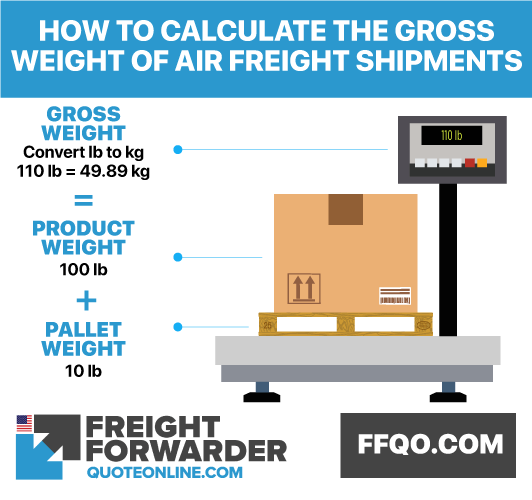
How to calculate for the gross weight of air freight shipments formula
What is air freight volumetric weight?
The air freight volumetric weight, or dimensional weight, is an estimated weight value based on a package’s length, width and height. It is a theoretical weight calculated using a minimum air cubic conversion factor (167) chosen by the freight carrier.
When using the air cubic conversion factor of 167, that volume and weight need to be metric. That is cubic meters for volume and kilograms for weight.
How to calculate the airfreight volumetric weight formula?
To calculate the air freight volumetric weight, you have to be careful to ensure the lengths are converted to meters and volumes are in cubic meters. Use this simple illustration below:
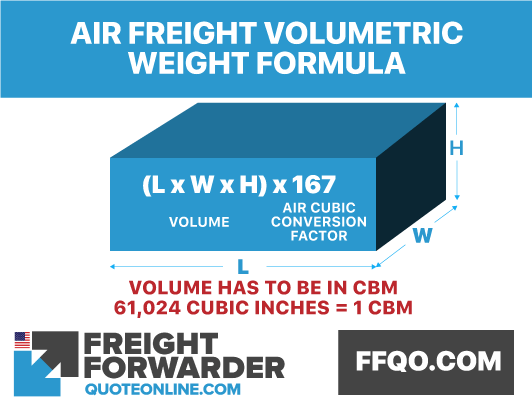
How to calculate for the volumetric or dimensional weight of air freight shipments formula
Understanding the difference between gross weight and volumetric weight
Volumetric weight is focused on measuring the space used by the shipment. Gross weight is more focused on the lightness or heaviness of the package. It is best illustrated using the below illustration:
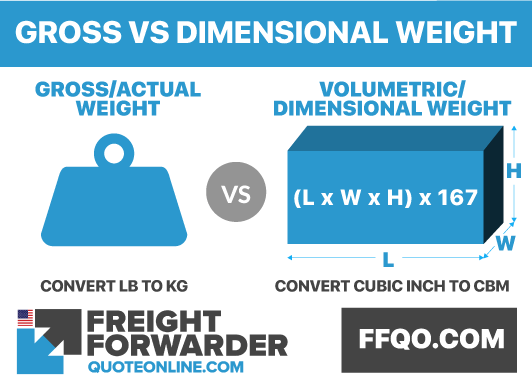
Gross vs volumetric or dimensional weight air freight formula for shipments
Why is there a need to calculate for the air freight chargeable weight of shipments?
You must be wondering why there’s a need to have two different measurements to calculate the airfreight chargeable weight of your shipment. It rests on the below principle.
Imagine a shipment of cotton and steel. It’s quite obvious that a cotton shipment will occupy more space than a steel shipment. A steel shipment, however, will weigh more. Should both be charged using volume? Or should they be charged on the basis of weight?
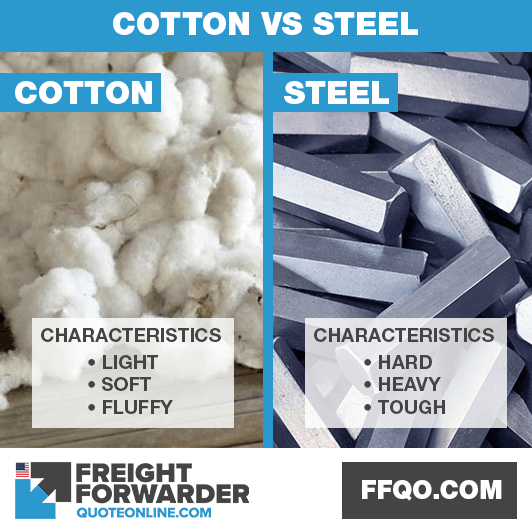
Example of gross vs dimensional volumetric weight with cotton vs steel
How do shippers go about this situation?
They choose the higher value between the volumetric and the actual weight of the cargo. This is fair enough, because cotton shipments will occupy more space while steel shipments will weigh more. In both cases, shippers will be choosing the measurement with greater value.
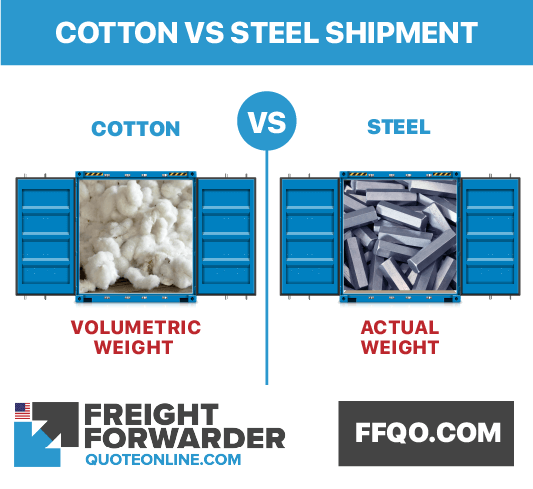
Air freight chargeable weight difference of cotton and steel
Steps on how to calculate the air freight chargeable weight
The following example explains how the air freight chargeable weight is to be calculated:
Example where gross weight is greater than volumetric weight
The gross weight of an air shipment can be higher in value compared to its volumetric weight. This makes it the chosen chargeable weight for the cargo as shown in the example below.
Shipment measurement:
- Length (l) = 40.16 in
- Width (w) = 38.58 in
- Height (h) = 41.73 in
- Gross weight (g) = 1,653.47 lb
Step 1: Calculate the volume of the air freight shipment
Volume = length x width x height
= 40.16 in x 38.58 in x 41.73 in
= 64,655.33 cubic inches
Step 2: Convert the imperial measurement (cubic inches) into cubic meters
To convert cubic inches into cubic meters, follow this formula: 61,024 cubic inches = 1 cbm
Thus: 64,655.33 cubic inches = 1.06 cbm
Step 3: Finalise the volumetric weight
Air cubic conversion factor = 167
Volumetric weight = CBM x 167
= 1.06 cbm x 167
= 177 kg
Step 4: Convert weight into kilograms
To convert pounds into kilograms, follow this formula: 1 lb = 0.4536 kg
Gross weight is 750 kg
Step 5: Compare the gross weight with the volumetric weight
Gross weight vs volumetric weight = 750 kg vs 177 kg
Chargeable weight is the greater value which is 750 kg.
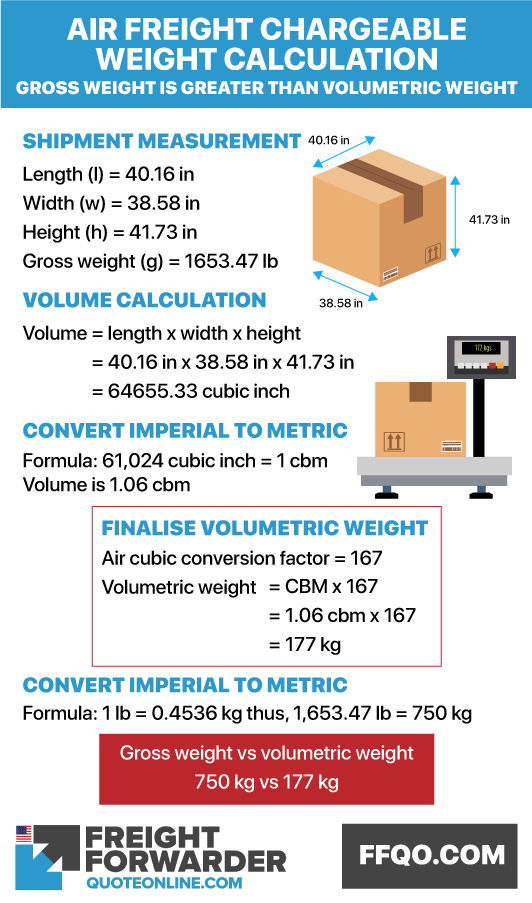
Example air freight chargeable weight calculation when gross weight is greater than volumetric weight
Example where gross weight is less than volumetric weight
At times, the volumetric weight becomes of greater value than the gross weight. In this instance, the volumetric weight is chosen as the chargeable weight.
Shipment measurement:
- Length (l) = 47.25 in
- Width (w) = 63 in
- Height (h) = 45.28 in
- Gross weight (g) = 1,102 lb
- Number of boxes =2
Step 1: Calculate the volume of the air freight shipment
Volume = (length x width x height) x 2
= (47.25 in x 63 in x 45.28 in) x 2
= 269,574.48 cubic inches
Step 2: Convert the imperial measurement into cubic meters
To convert cubic inches into cubic meters, follow this formula: 61,024 cubic inches = 1 cbm
Thus: 269,574.48 cubic inches = 4.42cbm
Step 3: Finalise the volumetric weight
Air cubic conversion factor = 167
Volumetric weight = CBM x 167
= 4.42 cbm x 167
= 738.14 kg
Step 4: Convert weight into kilograms
To convert pounds into kilograms, follow this formula: 1 lb = 0.4536kg
Thus 1,102 lb = 500kg
Step 5: Compare the gross weight with the volumetric weight
Gross weight vs volumetric weight = 500 kg vs 738.14kg
The chargeable weight is the greater value, which is 738.14 kg.
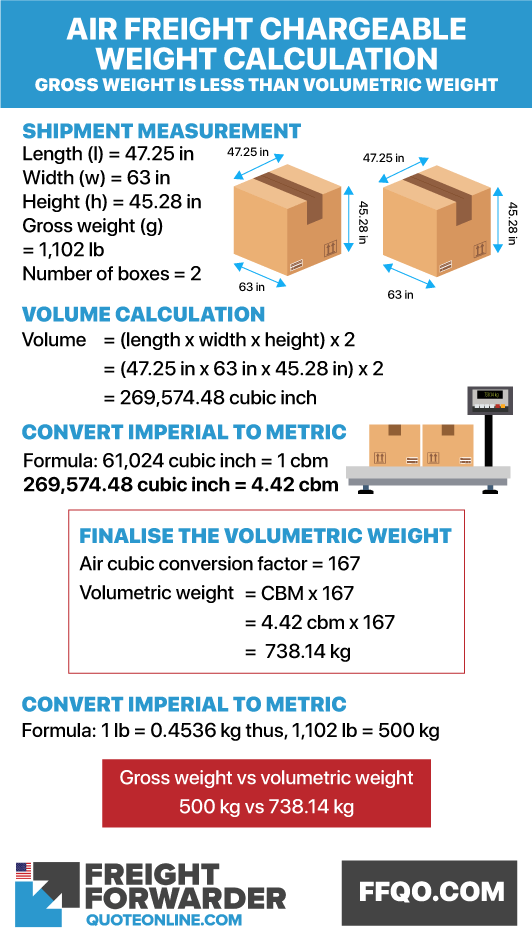
Example air freight chargeable weight calculation when gross weight is less than volumetric weight
How to calculate the air freight chargeable weight of an irregularly-shaped container
There are instances wherein the item that has to be shipped is irregularly-shaped. How is this to be calculated?
It is calculated in the same manner, however you need to know the right measurements of your shipment as illustrated in this image:
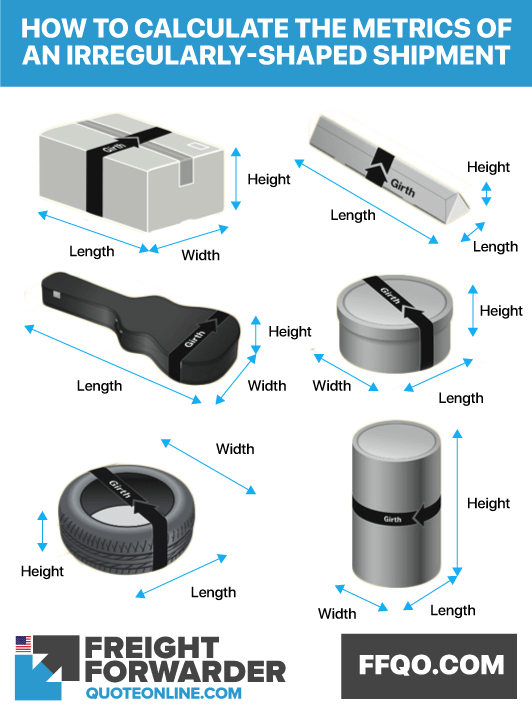
How to calculate air freight chargeable weight of irregularly-shaped objects
After listing the measurements, you may now use the formula or air freight as discussed above.
Use our easy-to-use online quote tool, otherwise send us a message for assistance.
Still need help with calculating air freight volumetric weight?
Do you need assistance moving your goods via air? We are happy to help you. We run a fast, lean and transparent air freight service, so contact us online and send a message. You can even message us on Facebook for a quote on doing your air freight.




